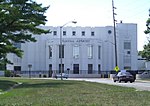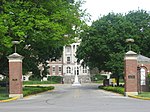Riverside Amusement Park (Indianapolis)
1903 establishments in Indiana1970 disestablishments in IndianaAmusement parks closed in 1970Amusement parks in IndianaAmusement parks opened in 1903 ... and 2 more
Defunct amusement parks in IndianaTourism in Indianapolis
Riverside Amusement Park was an amusement park in Indianapolis, Indiana, US from 1903 to 1970. Originating as a joint venture between engineer/amusement park developer Frederick Ingersoll and Indianapolis businessmen J. Clyde Power, Albert Lieber, Bert Fiebleman, and Emmett Johnson, the park was built by Ingersoll's Pittsburgh Construction Company adjacent to Riverside City Park at West 30th Street between White River and the Central Canal in the Riverside subdivision of Indianapolis.
Excerpt from the Wikipedia article Riverside Amusement Park (Indianapolis) (License: CC BY-SA 3.0, Authors).Riverside Amusement Park (Indianapolis)
Armory Drive, Indianapolis
Geographical coordinates (GPS) Address Nearby Places Show on map
Geographical coordinates (GPS)
| Latitude | Longitude |
|---|---|
| N 39.811111111111 ° | E -86.192222222222 ° |
Address
Armory Drive 3079
46208 Indianapolis
Indiana, United States
Open on Google Maps







